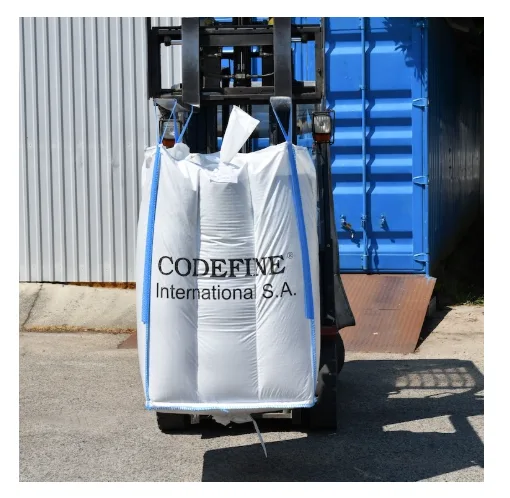Bulk Packaging’s Expanding Role in Global Supply Chains
As industries continue to scale, bulk packaging has emerged as a foundational component of modern supply chains. From the movement of grains across continents to the safe storage of hazardous chemicals, businesses now rely on solutions that are both cost-effective and capable of handling large volumes. Over the years, flexible intermediate bulk containers (FIBCs) have reshaped logistics in industries like agriculture, construction, and chemicals. Their space-saving design, durability, and reusability have contributed significantly to reducing packaging waste and improving storage efficiency. This evolution has introduced a new wave of innovation where performance meets sustainability. Today, several players offer products tailored to these ever-changing needs, and some are recognized among the leading FIBC bag manufacturers in the industry. To understand this shift, it helps to examine how global supply chains are adapting and where bulk packaging fits into the conversation. Keep reading to explore the growing importance of bulk packaging across key industries.
Meeting the Demands of Modern Agriculture
Agriculture remains one of the most critical industries for bulk packaging solutions. The need to store and transport large volumes of seeds, grains, fertilizers, and animal feed has made FIBCs indispensable on farms and in agri-based logistics. These bags offer a safe and efficient means to move dry, flowable materials while minimizing losses during handling and transit.
Seasonality and climate sensitivity mean that timing and storage conditions play a pivotal role in agricultural success. Bulk packaging allows for improved stockpiling, better inventory management, and quicker distribution when demand spikes. The UV stabilization and moisture resistance of many FIBCs also ensure that the contents remain protected even in outdoor environments.
Furthermore, automation in agricultural processing and packaging centers has increased the demand for standardized packaging solutions. FIBCs are designed to work seamlessly with forklifts, conveyors, and filling stations, streamlining operations and reducing manual labor. With rising food demand and international export trends, having dependable packaging is no longer optional—it’s essential to keeping global agricultural cycles running efficiently.
Supporting the Construction Sector’s Heavy Lifting
In construction, materials such as sand, cement, gravel, and crushed stone need to be moved in large quantities with minimal disruption. This is where bulk bags prove especially useful. Their ability to handle heavy loads with structural integrity reduces the need for smaller, single-use containers that add clutter and increase costs.
The construction industry also values speed. Project deadlines are tight, and efficient material handling can make or break timelines. Bulk bags offer fast loading and unloading capabilities and reduce spillage risks on-site. With the correct lifting loops and discharge spouts, these bags can be customized to suit specific project requirements.
Moreover, construction environments are rugged. Packaging solutions must resist abrasion, rough handling, and exposure to the elements. FIBCs made with reinforced stitching and woven polypropylene offer the durability required for such conditions. By minimizing material losses and streamlining logistics, they contribute to cleaner worksites and more organized supply zones.
For large infrastructure projects, consistency in material supply is crucial. Standardized bulk packaging ensures that every delivery meets the same safety and quality benchmarks, enabling smoother planning and execution. This reliability plays a critical role in reducing delays and improving on-site coordination.
Adapting to the Needs of the Chemical Industry
Handling chemicals requires a different level of caution. Whether transporting powdered substances or crystalline compounds, packaging must meet stringent safety and compliance standards. FIBCs have evolved to include features such as electrostatic protection, dust-proof seals, and inner liners, making them suitable for chemical-grade use.
Bulk packaging in this sector goes beyond convenience—it’s about mitigating risks. Antistatic Type C and Type D FIBCs reduce the danger of sparks during filling and discharging, especially in volatile environments. These bags are engineered with safety at the forefront, aligning with hazardous material guidelines while maintaining handling efficiency.
The chemical industry also places a premium on traceability. FIBCs can be barcoded or tagged to integrate with digital inventory systems, making it easier to track materials through various phases of production. This is especially important for manufacturers managing multiple chemical grades or customized formulations.
Environmental safety is another factor. Leaks or spills during transit can have serious consequences. Well-constructed FIBCs help prevent such events through secure closures and high-tensile strength fabric. Additionally, companies are now leaning toward recyclable materials and reusable bag designs, making FIBCs more sustainable for long-term operations.
Sustainability Driving Innovation
Sustainability is becoming a non-negotiable across all industries, and packaging is at the forefront of this shift. Bulk bags made from recyclable materials and reusable over multiple cycles offer a viable alternative to traditional packaging waste. This not only lowers the carbon footprint but also cuts down on procurement and disposal costs.
Reusable FIBCs are especially attractive in closed-loop supply chains where materials circulate between the same parties. For example, fertilizer manufacturers delivering to large farms often recover the same bags for refill. Similarly, food-grade FIBCs used for sugar or flour can be sterilized and used again with the right equipment and protocols.
Beyond reusability, lighter packaging translates to reduced fuel consumption during transportation. As businesses face mounting pressure to meet ESG goals, even minor packaging improvements can significantly impact environmental reporting.
Suppliers are now investing in biodegradable additives, water-based inks, and solar-powered production to further reduce their ecological impact. These innovations not only align with regulatory shifts but also resonate with eco-conscious buyers who expect sustainability to be embedded into the products they choose.
Designing for Global Logistics and Efficiency
Global trade operates at an unprecedented scale, and bulk packaging must keep up. From warehouses to shipping ports, the materials used in packaging affect everything from cargo space utilization to loading times. FIBCs are designed to optimize these logistics, offering stackable, collapsible, and easily palletized formats that fit seamlessly into shipping containers and warehouse racks.
Their square or circular shapes help minimize unused space, allowing for more product per shipment without compromising safety. The use of conductive or anti-static features further ensures compatibility with international safety standards, making cross-border transportation safer and more compliant.
Efficiency doesn’t end at transport—it extends to storage. With the right storage racks or hanging systems, bulk bags can be stored vertically in minimal floor space, which is particularly valuable in crowded industrial settings. Labeling and color-coding options also make inventory sorting more manageable.
For exporters, FIBCs reduce the need for secondary packaging, cutting costs and labor hours. Their tamper-proof seals and durable materials offer peace of mind when shipping high-value or sensitive materials. As e-commerce and global sourcing continue to expand, packaging must meet not only regulatory requirements but also the practical challenges of distance, climate, and scale.
The evolution of bulk packaging is ongoing. As industries seek better ways to manage volume, improve sustainability, and drive cost efficiency, FIBCs continue to offer versatile and proven value. From farming cooperatives to chemical plants and major construction firms, these bags play a silent but vital role in moving the world forward, safely and efficiently.




